Launch
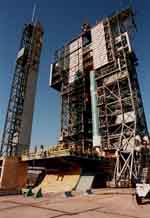
|
| Delta II rocket prepares for launch.
|
The microprobes are piggybacking to Mars on board the 1998 Mars Polar Lander
Spacecraft which was launched on a McDonnell Douglas Med-Lite (Delta II 7425 configuration)
in January, 1999.
Deep Space 2 is paying a small fee for the ride to Mars. Not requiring a
launch vehicle for this mission has saved taxpayers tens of millions of dollars.
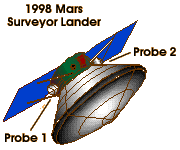
Cruise
During its 11 month journey to Mars, the 2 probes are attached to the
1998 Mars Polar Lander Spacecraft's cruise stage, underneath the Lander's solar panels.
To simplify cruise operations and the probes interface with the lander,
there are no electrical interfaces between them. The probes are powered off during cruise,
thus, there is no communication with them from installation on the launch pad until after
impact with the Martian surface.
By not commanding the probes during cruise, the Deep Space 2 probes save
taxpayer dollars.
Destination and Separation
After an 11 month cruise, the Mars Lander and the DS2 probes will
arrive at Mars near the south pole. The arrival parameters are designed to target
the Martian Polar Layered Terrain (PLT), which is of significant scientific interest
due to its role as a reservoir for water and other volatiles on Mars.
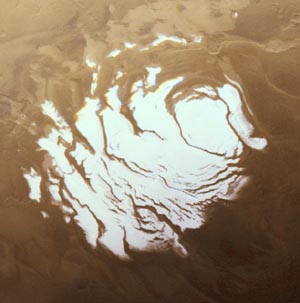
Permanent Carbon Dioxide South Polar Ice Cap
DS2 landing site, just
outside the ice cap.
The high latitude landing site will provide unique opportunities for
the 1998 Mars Surveyor Lander to study the distribution and behavior of Martian
volatiles, as well as aspects of the climate history of Mars. The probes are
expected to land approximately 100 kilometers (60 miles) from the main Lander.
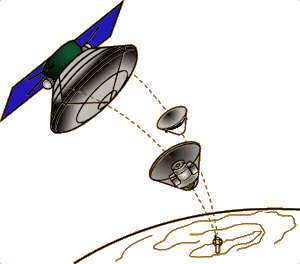
Just prior to entering the atmospheric, the 1998 Mars Lander will
separate from its cruise ring. The force of separation will initiate mechanical
pyro devices, which in turn will separate the probes from the cruise ring approximately
18 seconds later.
Entry, Descent, and Impact
Because the microprobes separate from the aeroshell pointed orthogonal
to the velocity vector and because the probes have no active control, attitude
determination, propulsive system, or spin stabilization, they will not control their
orientation or tumble rate at entry. In fact, the probes have been designed to
passively re-orient themselves from almost any entry attitude or condition, including
entering completely backward or with a small initial tumble rate.
The microprobe entry, descent, and impact (EDI) system is single
stage from atmospheric entry until impact. The non-erosive aeroshell uses an
advanced ablative material, which can withstand temperatures associated with
heating rates up to 300 W/cm2 (up to 3000 degrees F). This material
provides a significant mass advantage over traditional aeroshell designs, and
maintains a constant aerodynamic shape. The aeroshell will fall to the Martian
surface, and will shatter upon impact, leaving the penetrator aftbody clear for
communications with the Mars Global Surveyor spacecraft.
Shortly before entering Mars' atmosphere, the probes will turn
on a descent accelerometer which will sample "G" forces 20 times a second until
impact. This single piece of information can allow scientists to develop profiles
of many meteorological factors in Mars' atmosphere including density, temperature
and pressure at various altitudes.
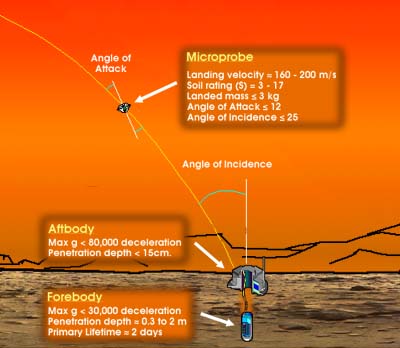
The microprobes are expected to hit the surface with an impact
velocity of approximately 644 km/per hour (~400 miles/hour). Upon impact, each penetrator
will separate into a fore and an aftbody that are connected via a cable system.
The forebody is expected to penetrate to a depth of 0.3 to 1 m for soil types
that vary from frozen-soil to very loose fine-grained soil, respectively. The
forebody must also withstand a peak rigid body shock of up to 30,000 Gs (1 G is
the force a person feels at sea-level). The aftbody is designed to stay on
the surface, and withstand a peak rigid body shock of < 60,000 Gs.
Landed Operations
After their rapid descent and during their abrupt landing, each
microprobe will separate into a fore and aftbody system connected by only a
flexible interconnect cable. The forebody, which will be buried in the soil, is
designed to operate in temperatures which may range from 0 to -120° C (32° to -184° F).
The aftbody, which will remain on the martian surface, is designed to operate in
temperatures which may range from 0 to -80° C (32° to -112° F)
(Earth's coldest, harshest environment, Antarctica, is comparatively balmy,
with an average temperature of about -57° C (-70.6° F)).
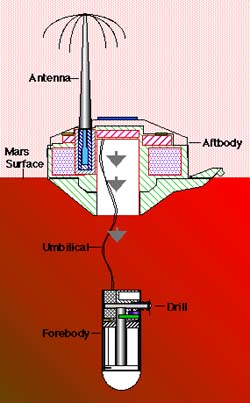
Upon impact, an accelerometer will measure the deceleration of the forebody
before it comes to rest in the martian soil. This data may provide clues to climate history
if geological stratification or an ice layer is detected below the surface. Accelerometer
data will also provide information on the depth of probe penetration.
For the first 30 minutes following impact, the probes will use temperature
sensors in their forebodies to show how quickly the probes cool when embedded in the
frigid Martian soil. This will provide information on the conductivity of the soil
which will give scientists clues about the soil's composition and heat flow characteristics.
The Deep Space 2 primary mission will end with the transfer of one data
set to earth via the Mars Global Surveyor (MGS) Spacecraft, which has been orbiting
the Red Planet since September 1997. One data set will provide sufficient information
to validate the project's engineering technologies. Each probe will transmit data to
MGS using a radio operating the UHF band (at frequencies near the upper channels of a
conventional TV set) at a rate of 7,000 bits per second. The first such communications
session is expected within two hours after impact. Normally each probe will be in a
low-power listening mode until it receives a signal from MGS telling it to transmit
data. The orbiter will temporarily store the data and transmit it to Earth as soon
as soon as it can.
After the first data transmission has taken place, a micromotor will
drive a small drill bit out the side of the probe's forebody. Bits of soil engaged
by the drill bit will fall into a small heater cup, which is sealed by firing a pyro
which closes a door. The soil is then heated, driving any water vapor into the
analysis chamber. If water is present, it will be detected by measuring the difference
in light intensity of a tunable laser shining through the vapor. The tunable laser
is set so that its light is at the point in the spectrum where water absorbs light.
Collection of a subsurface soil sample is an important demonstration
for future science missions that will attempt to analyze soil samples not affected
by adverse atmospheric conditions such as chemical erosion and weathering. Information
regarding whether water ice is present or absent at depth will be compared to the
analyses of soils excavated by the robotic arm on the Mars Polar Lander spacecraft.
These data will help to refine theories as the fate of the water that once flowed on
the surface of Mars.
The Deep Space 2 probes will continue to operate and transmit data
until the batteries are depleted, which is expected to occur 1 to 3 days after impact.
|


